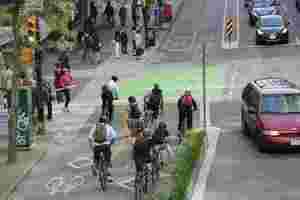York is using real-time traffic models to manage roads and reduce pollution
This article was originally published by Christopher Carey on Cities Today , the leading news platform on urban mobility and innovation, reaching an international audience of city leaders. For the latest updates, follow Cities Today on Twitter , Facebook , LinkedIn , Instagram , and YouTube , or sign up for Cities Today News.

The City of York has launched what it claims is the UK’s first municipal-wide real-time transport modelling system.
Working in partnership with PTV Group, Wood Group and modelling firm RelativeGAP, the city council is now using the technology to manage its road network and monitor areas with no sensors or cameras.
The system combines offline transport models with live traffic data to provide the council’s control room with a network-wide forecast of current and predicted congestion. It has already reduced travel times by almost ten percent in testing areas.
Evolution
The deployment is part of the council’s Smart Travel Evolution Program , which was awarded £2.85 million (US$4 million) by the UK government in 2018.
“We’re delighted to be the first city in the UK to introduce this innovative and cutting-edge technology to improve journeys and reduce pollution in York,” said Dave Atkinson, Head of Programs and Smart Place at City of York Council.
“At this early stage it’s already proving to be a success. We’re able to predict future traffic levels based on our live traffic behavior and manage the flow of traffic better in busy periods by adjusting traffic lights to best suit traffic conditions.
Integrated network
In the past, the council managed the transport network through CCTV and social media feeds, with network monitoring operators (NMOs) and transport engineers manually implementing new plans and signal changes to ease issues.
The York Optima model is integrated with over 100 live traffic flow sensors, more than 100 live signal controllers, live speed data across the network provided by TomTom, and up-to-date information about roadworks and other network changes.
It combines all this data into a single view, so the control room can see in detail what is happening across the whole network, and not only in those locations with sensors or CCTV.
The Optima model also allows the control room to test alternative scenarios for the hour ahead, next day, or weeks in the future.
Do EVs excite your electrons? Do ebikes get your wheels spinning? Do self-driving cars get you all charged up?
Then you need the weekly SHIFT newsletter in your life. Click here to sign up .
Watch the Nevera hypercar get smashed in crash test — the dummy survives!
Ever wanted to watch a $2.4 million, 1,914 horsepower car get mangled? Well, friends, you’re in luck .
The video in question is from Carwow’s Mat Watson, who joined the final crash test of the Rimac Nevera, a battery electric hypercar . It’s the last installment in a series of 44 trials required for certification before its official rollout in Europe and the US.


Once you move past the pain of watching this much money bursting into flames, there’s actually a lot to learn.
The car goes through a side pole crash test, as in it literally gets smashed into a pole at a 32km/h speed. Of course, the Nevera suffered some damage: the impact crushed the door, the side window was all cracked, and its carbon body was fractured.
But — and here’s the cool part — none of the damage was irreparable or life threatening. The vehicle’s exterior absorbed most of the impact’s force, the airbags went off as they should have, and the crash dummy was found safe and sound.
In fact, the Nevera passed the crash test with flying colors. Not only did the test’s results exceed the legal limits, but it also beat the safety targets Rimac had set.
But what impressed me the most was the complexity of the test process itself: from the technical equipment and the standards for crash dummies, to the choices of the manufacturers.
Intrigued yet? You should be! Go and watch the video yourselves!
What you need to know about ’15-minute cities’ — the future of sustainable urban life
Welcome to SHIFT Basics , a collection of tips, explainers, guides, and advice to keep you up to speed with mobility tech.

As the coronavirus pandemic took hold, many of us started working from and spending much more time at home. The situation has made us far more aware of how our neighborhoods are built around driving, working life, and commuting by car.
It’s got many of us asking: are our neighborhoods really as good as they can be?
Over the past year, cities around the world have experimented with low-traffic neighborhoods, with much success . But a bigger idea is afoot, rather than blocking just a few streets to cars, to encourage cycling and walking, some are lobbying for entire cities to be restructured and redesigned to better support modern sustainable living where the car isn’t the focus.
The 15-minute city
One concept that’s been gathering momentum in recent months is the “15-minute city.”
In short, the 15-minute city is an urban planning model which is designed to improve quality of life and bring communities together. It might sound like a bougie utopia, but it makes a lot of sense when you dig beneath the surface.


How does it work?
Reports suggest that the more dependent we are on cars, the worse our overall health becomes. When most cities and towns are built to support private car journeys, it’s not surprising that most people opt for that mode of transport out of convenience, even if it costs us our health and wellbeing.
Favoring the car over all other modes of transport is leading us down an unsustainable path towards pollution, ill health, and cities that are kinda rubbish to actually live in.
The 15-minute city turns most contemporary city planning on its head.
The concept is simple and is basically summarized in two steps:
Structuring cities in this way helps reduce residents’ reliance on cars for transport. With few cars on the roads it makes cities safer for everyone, and walking or biking to the shops is far healthier than driving for the individual too. The theory goes that 15-minute cities are far better all-round for our quality of life.
The reality, though, is that building 15-minute cities is far more complicated, long-winded, and difficult.
As every city is different from the next, there’s no hard and fast formula for how to turn each one into the perfect 15-minute city.
Among attempts to restructure cities in this way, one thing is common: politics.
Paris’ mayor Anne Hildago is one of the most well-known proponents of the 15-minute city. The French capital’s plans to restructure itself around the concept are some of the most talked about in the world , and have been a core component of Hildago’s campaign manifesto.
Getting an entire city to buy into the idea takes a lot of persuasion and time, and it requires broad political support to make 15-minute cities a reality.
More than just an objective
With most western cities being built around the car, turning them into 15-minute cities requires significant short-term disruption as roads are rebuilt to better support cycling and public transit.
Building a city where everything is within easy reach by bus or bike also seems to be a never-ending story. That’s not to say that it’s impossible to build the perfect 15-minute city, some cities like Amsterdam and Copenhagen are close, but even those cities are constantly reassessing how they can keep improving the format.
As 15-minute cities encourage more people to leave their cars at home for short journeys, demands on cycling, walking, and transit infrastructure inevitably increase. In some cases, it reaches capacity and needs further improvement to meet the new demand.
Many of us are pining to get back to the office, but it seems that working from home and spending much more time where we live will be a huge part of our future. With that, we are starting to take how our neighborhoods impact our health and safety far more seriously.
Low-traffic neighborhoods are proving their effectiveness, in London research suggests they have made roads three times safer. A lower reliance on cars, and greater use of more active transport like bikes and walking, is also great for our health.
It seems the next step is to apply that idea to entire metropolises and make 15-minute cities the future of our urban life.
While the concept is clear, it remains an elusive goal that ebbs and flows with the natural evolution of cities that occurs as people come and go, and move about their daily lives.
We should look at 15-minute cities not with an objective in mind, but as a philosophy for designing better cities for modern living.
On the surface, 15-minute cities are pretty simple, but if you want to learn more about them and how they work, there are some great resources here from: BBC’s Worklife , City Monitor , MobyCon , Raconteur .
SHIFT is brought to you by Polestar. It’s time to accelerate the shift to sustainable mobility. That is why Polestar combines electric driving with cutting-edge design and thrilling performance. Find out how .